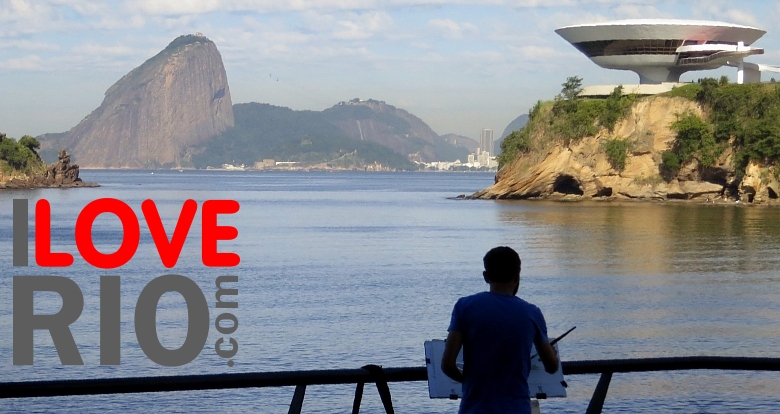Niterói
Sitting just across Guanabara Bay from Rio de Janeiro is her sister-city Niterói, sharing a unique and deep connection dating back to the very beginning of the two. Meaningful today as it was in the past, Niterói adds a whole new dimension to the discovery of Rio de Janeiro city and State.
As part of I LOVE RIO's philosophy to broaden cultural horizons in the state of Rio, the portal covers in detail various aspects of Niterói's cultural and touristic catalog. Secluded beaches, architecture, museums, cinemas, parks, tours, sensational views, restaurants, theatres, sporting competitions and recreations, as well as flashbacks to important epochs in the region's history, easily position Niterói at the heart of the state's scenic, cultural and intellectual milieu.

THE ONLY BRAZILIAN CITY FOUNDED BY INDIGENOUS INDIOS
Niterói sits in Guanabara Bay just across from Rio de Janeiro, with a distance of about 7 miles between the two, with a bridge connecting the cities. Niterói, or rather, the land which Niterói now occupies, was originally called São Lourenço dos Índios when it was first settled in 1573 by Araribóia, a Tupi-Guarani chief - it is the only Brazilian city to have been established by an indigenous leader.
Niterói is one of the most important regions in Rio de Janeiro state's history, with a profusely rich and significant past. Today, it is the fifth largest city in the state, divided into 52 neighborhoods, with a population of around 500,000.
It is the city with one of the highest qualities of life in Brazil, and has the highest income per capita and the highest literacy rate in the state. It also teems with fascinating museums, historical monuments and lush green expanses for exploration.
Deeply and inextricably connected to Rio de Janeiro city historically, culturally, and geographically, Niterói should be on everyone's itinerary while visiting the capital, as it offers new perspectives on the overall region and is home to truly unique and unforgettable landmarks many of which are easily accessible from Rio de Janeiro.
Niterói's coat of arms has three dates engraved upon it: 1573, 1819 and 1835. The fist of these dates refers to the official year of the founding of the city by Araribóia, the chief temiminós Índio who had been brought in to help in by the Portuguese in the war effort against the French. The village, named São Lourenço dos Índios, was installed atop a hill, making a surprise invasion almost impossible. It was the first and only city in Brazil to have been founded by Índios.
During this first century, the region received other settlers such as the Jesuits who installed a farm for the production of food. Economic development was accentuated with the production of farms, sugar mills, trade and transportation.
When King João VI and his court arrived in the Brazilian colony in 1808, a number of parishes in the region received significant developments, most notably São João de Icaraí (St. John of Icaraí), São Domingos (Saint Sundays) and Praia Grande (Big Beach), where he celebrated his birthday. In 1819, the second date on the city's coat of arms, the region was established as the Vila Real da Praia Grande (Royal Village of Big Beach), and from that point on its political and social identity was made distinct from the then city of São Sebastião do Rio de Janeiro (Saint Sebastian of Rio de Janeiro).
In 1835, second important date in the history of the city, is when Vila Real da Praia Grande (Royal Village of the Big Beach) was decreed the capital of the province with Rio de Janeiro, seat of the general government.
It was therefore elevated to the status of city and renamed Nictheroy, which is most commonly thought to mean “hidden water" in Tamoios indigenous language. In 1841 the city gained the honorable title of "Imperial City", visited by the young emperor Dom Pedro II for ceremonies and theatre performances. It was gradually revitalized in line with the Plano Taulois (Talouis Plan), developed by French engineer Pedro Taulois. This effort effectively doubled the urban area of Niterói.
Improvements in the capital were incrementally implemented, such as the steam boat in 1835, whale oil public lighting in 1837, gas lamps in 1847, water supply in 1861, the Niterói Railroad, linking the city with the wider state in 1872, and electric streetcars in 1883.
In 1894, due to a series of revolts and attacks on the city, the capital was transferred to Petrópolis. However, Niterói was reinstated as capital in 1903, which marked a period of important urban interventions.
In 1906 electric lighting and drains were installed and electric trams began to replace donkey-pulled ones. The Cassino Icaraí (Icaraí Casino) rivaled the Cassino da Urca (Urca Casino) in Rio de Janeiro city, featuring a hotel, restaurant and gambling rooms, as well as great names in Brazilian and Latin American music.
In the 1970s the Ponte Presidente Costa e Silva (President Costa and Silva Bridge) was built, better known as the Rio-Niterói Bridge, one of Brazil's most imporant engineering landmarks. In 1974 a new law resulted in the states of Guanabara and Rio de Janeiro to be merged, resulting in Niterói no longer being the capital. This led to many changes and to much of the population of Niterói to migrate.
In the late 1980s, the city rediscovered its cultural heritage and vocation. Important buildings and sites were constructed and restored, such as the Teatro Municipal João Caetano (João Caetano Municipal Theatre) and the Igreja de São Lourenço dos Índios (Saint Laurence Church of the Indigenous).
Today, Niterói is one of the most important cities in Brazil, and home to a variety of attractions and events that both stands on their own and tell the story of the close relationship and deep connection the city shares with nearby Rio de Janeiro.
One of the most celebrated attractions in Niterói is the iconic "Museu de Arte Contemporânea MAC," the Museum of Contemporary Art and symbol of the city. Designed by the famous architect Oscar Neimeyer, the ufo-shaped establishment boasts superb views over the Gunabara Bay and Corcovado and Sugar Loaf Mountains. Neimeyer envisaged the museum to be “something loose in the landscape, a white bird flying over the sky and the sea of Niterói", or "a flower born in a rock". Inaugurated in 1996, it has become a world-renowned reference in art, architecture and tourism.
Other important museums and galleries include the Museu de Arte Sacra (Museum of Sacred Art), home to a rich collection of historical and religious artifacts, and the Museu de Arqueologia de Itapú (Archaeological Museum of Itapú) which relates neraly 8,000 years of the region's history. Among the highlights of the collection are deposits of shells, instruments, stones, human skeletons and other materials that attest to everyday hunting, fishing and gathering practices in the oceanic region prior to the discovery of Brazil. The Solar da Jambeiro is a stunning mansion, built in 1872, with beautiful tiles, nineteenth century facades, balconies and salons.
Important historical sites in the city include the "Forte da Boa Viagem," a historic monument of the colonial period, which poetically contemplates the Guanabara Bay. Another is the "Fortaleza de Santa Cruz" (Santa Cruz Fortress), built in 1555, comprising a collection of eighteenth and nineteenth century guns and a chapel from 1612.
The natural wonders in and around Niterói are both numerous and awe-inspiring. The city has a range of spectacular beaches, including Icarai, which is the best known in town, lined with almond and coconut trees. Praia do Sossego (Relaxation Beach), Itapú and Itacoatiara are also jewels along the city's coast. Niterói has both ocean-facing beaches with strong waves ideal for surfing and sports, and bay-facing beaches with calm waters ideal for family activities and relaxation.
On the wilder oceanfront, beaches such as Prainha de Piratininga, Praia de Itaipú and the gorgeous Praia de Itacoatiara are not to be missed. Itacoatiara beach, nested at the bottom of Pedra do Elefante and surrounded by beautiful nature and mansions, is considered one of the most beautiful beaches in the entire state. Near Praia de Itaipú is also Lagoa de Itaipú, a placid lagoon where many go to fish, swim and relax.
The region also boasts a range of delightful green expanses. "Parque da Cidade," or City Park, offers beautiful views of the sandy shores of Niterói, as well as a truly spectacular view of the region, including Guanabara Bay, Sugarloaf, and Christ the Redeemer. The site is also a highly desirable spot for paragliding, because of its impressive height, views, and favorable winds.
The Serra da Tiririca is a vast area of lush Atlantic Forest, populated by orchids and natural wildlife, such as armadillos, skunks and hedgehogs. "Pedra do Elefante," or Elephant Rock, is situated on the highest point of the Serra da Tiririca, between the inviting stretches of Itapúaçu and Itacoatiara beaches and surrounded by lush rainforest. The great rock, which bares an impressive resemblance to the head of an elephant, offers wonderful panoramic views of Rio - the seas that lap against the bays of Niterói, the Maricás islands, and the majestic mountains.
Further, the cast expanse of Serra da Tiririca state park contains hiking and climbing hotspots such as Alto Mourão and Morro das Andorinhas, combining amazing views with rich vegetation and, aside from offering trails with spectacular views, in 1992 the park was named world biosphere reserve by UNESCO.
Annual events in Niterói, have reached a level of organization and promotion in recent years that was unseen as recently as a decade ago - contributing factors include the growth of tourism and population in the Guanabara Bay area, and the formation of organizations that put together new projects and helps to divulge existing ones.
The months of December, January and February tend to revolve around the traditional southern hemisphere summer events such as Christmas, New Year (Réveillon) and Carnival. The official Réveillon party takes place on Praia de Icaraí, one of the most famous beaches in Niterói. On this beach, for three days people anticipate and get ready to party for the big day, and over this pre-Réveillon atmosphere there are several musical performances, from Rock to Samba, while fireworks are tested.
July brings with it the winter festival, which includes a wealth of action sports events such as the skateboarding championship, at the São Francisco Beach marina, and the paragliding tournament, at parque da cidade, on top of morro da viração. The newest addition to the festival is the Stand-Up Paddle Jurujuba-Icaraí crossing, which is a nod to the growing popularity of this new twist on surfing.
In July, the city hosts 'Niterói em cena', or the Niterói sketch festival, where dramatic pieces of 15 minutes or less in length are exhibited for a panel of professors and directors from local theater schools, as well as for the general public.
It is a competitive exhibition of short theater pieces with paid prizes for the top three sketches among adults and children in addition to best playwright. In August, the Niterói Jazz Festival brings together local artists with others from around brazil and the world to perform free outdoor concerts - only the opening event is exclusive to ticket holders.
Throughout the year a plethora of artistic, sporting and cultural events pepper the calendar ensuring the perfect balance in Niterói's social, cultural, and recreational landscape.


